Winding up Wind Power
With energy prices sky high, we continue our alternative energy month with a look at wind power. Over 10,000 wind turbines on- and offshore in the UK are grabbing the breeze to power our homes. But how much of a role will this power play in our mission towards net-zero? We visit a traditional windmill to understand how humans have historically harnessed the wind, learn about the turbines which you can buy a stake in, and a new generation of kites that capture the wind and turn it into electricity. Plus, can we increase energy companies' usage of wind power by improving forecasting? Will its intermittency be a hindrance to its wide scale adoption? And if we continue to erect more of these massive turbine farms offshore, how will their presence impact wildlife?
In this episode
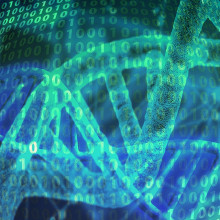
01:15 - Discovery of DNA Structure: Jubilee Science
Discovery of DNA Structure: Jubilee Science
Chris Smith, The Naked Scientists
It’s the Queen’s Platinum Jubilee and we’re doing our bit here on the programme to mark the occasion by selecting some of the standout scientific highlights that have happened during the last seven decades. To kick us off, all of us are the products of the genes we inherit from our parents. They are written into the molecules of DNA - millions of miles of it - packed inside almost all of our cells. DNA is life’s recipe book, so understanding it marks one of the biggest breakthroughs in biology. It’s a British achievement that’s changed the world and one of the first scientific highlights of the Queen’s reign. Chris Smith tells the story…
In 1953, not long after Queen Elizabeth II came to the throne, two scientists walked into a bustling Cambridge pub and announced, over a beer, that they "had discovered the secret of life". That pub - the Eagle - now has a brass plate documenting the occasion and the place where Francis Crick and James Watson made that pronouncement not long after Noon on February 28th.
Although many present at the time probably dismissed it as mere braggadocio, it really was a turning point for biology. What the duo had discovered was the structure of the DNA molecule that's present in the heart - or nucleus - of most of the cells in most living things.
Assisted by x-ray images of DNA, crystals prepared by Rosalind Franklin, Watson and Crick worked out what DNA was made of and how it fitted together. It consists of two strings of letters, one the mirror image of the other, and both twisting together into a long helix.
There are four letters or bases in the DNA, alphabet dubbed A, C, T, and G, And the order of those letters spells out words that we call "genes". These are the master recipes of all of the chemicals, molecules, and structures that an organism uses to operate. And, incredibly, the same code works in all living things, whether it's a bacterium, a banana or a person. So a gene from a jellyfish can be added to a human cell and it will make it glow green, just like it did in its original owner. And that is why Watson and Creek claimed, quite rightly, to have found the secret of life over their lunchtime pint back in 1953.
Since then, the world of molecular biology has exploded. Just in time for her Majesty's Golden Jubilee, back in 2002, a team at the UK Sanger Centre, together with US researchers, announced they had decoded the 3 billion genetic letters in the human genome.
In the years since, techniques have become even more powerful. Millions of COVID tests being done every day during the pandemic used the PCR technique to look for genetic signatures of the coronavirus to make those diagnoses. The process of DNA fingerprinting means we can reunite long lost relatives, absolve people of crimes they didn't commit, and catch the criminals who did do it.
Now, 70 years since Watson and Crick made their announcement, we're using that same science they unlocked to edit DNA, cure diseases, and even make tomatoes containing extra Vitamin D as we heard last week. I wonder if they saw that coming all those decades ago?

04:58 - Why popular baby names boom then bust
Why popular baby names boom then bust
Mitchell Newberry, University of Michigan
Perhaps there’s been a recent birth in your family? If so, are the new parents being swayed by popularity trends? Mitchell Newberry is an evolutionary biologist at the University of Michigan, and he explained to Julia Ravey what drives the popularity of baby names…
Mitchell - As soon as a name gets about one in 500 or 100 babies, people really don't want to use it anymore. And if you look at the most popular names at any given point in time, they're probably part of these boom bust trends. And so those names get more popular than any other names really do.
Julia - So you mentioned there, there were these boom bust cycles with names. What exactly are those?
Mitchell - Some names, like for example, Britney, just didn't even exist before about the 1950s in the US. And then by 1990, it was the most popular name. And about 75% of people that were named Britney were born between 1985 and 1995. So this name went from something that really nobody had ever heard of to being the most popular name. And then the trend went out as quickly as it had come in.
Julia - And why do you think we steer away from names once they reach a certain frequency in the population?
Mitchell - Well, it's probably just what it is to be a name. We wanna be able to identify ourselves. And so being unique as part of what a name is, and I don't know about you, but my elementary school classes had two or three Jessicas per classroom. You know, so maybe that's annoying
Julia - Are the names that retain a certain frequency in the population?
Mitchell - Yeah. So not all names are boom bust. There's plenty that are perennially popular, maybe because they're just in this cultural repertoire. So we've noticed for example, names that are in the Bible tend to be given a little more often than other names.
Julia - Does it also coincide with instances in popular culture? So if a film comes out?
Mitchell - Yeah. So names do respond to popular culture. And one of my favourite examples of this is Maverick, which didn't used to even be a name. It was a last name, but there was a cattle rancher in Texas who refused to brand his cows and the cows that didn't have a brand became Mavericks because they were renegades or, you know, this Maverick character, he wasn't mainstream. So it started to refer to a personality type. And then Tom Cruise in Top Gun got Maverick as a nickname. And then gradually over the last 30 years or so Maverick gradually became a name that people would actually name their babies. And today it's the 50th most popular name in the US.
Julia - Oh my goodness. Are we seeing, as we become more individualistic as a society with, you know, the rise of social media, all of us are being sort of driven to be these individualized selves. Have we seen changes in the frequency or uniqueness of names like this Maverick example, a name just sort of coming out of nowhere?
Mitchell - Yeah. Well, we're able to kind of measure at what frequency in the population a name really starts to be rejected because it's too common and that frequency has somewhat declined over the last hundred years in the United States, but we've actually also been able to show that people's sensitivity to how common a name can be before they start to reject. It has also changed. So people are more sensitive to how common a name is than they were in the past.
Julia - Right now in the UK, the most popular girl's name is Olivia and the most popular boy's name is Oliver. So how long do you think they'll sit on the top spot?
Mitchell - That's so interesting because a friend of mine asked me to consult with them about naming her baby. And she gave me a candidate list of names and they actually included Olivia. And I looked up the whole list of names in the database and found that my friend is actually quite on trend. All of the names that she gave me are trending upwards right now in popularity, but they all had a curious similarity that they had also had big trends about a 100 to 120 years ago. And so some of these trends that are currently happening, like I said, if any name that's the top name at any given time is likely to be a trend. And so it's likely to fall out of fashion, roughly the same way that it fell in, but these names that are popular now and Hazel and Emma are some other examples were also popular a hundred years ago. And so these trends kind of cycle on these long intergenerational timescales.
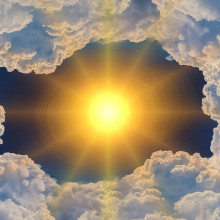
10:04 - Antarctica's ozone hole: Jubilee Science
Antarctica's ozone hole: Jubilee Science
It’s 1985, Liz has been sat on the throne for 33 years. Ireland will win the 5 nations, Like A virgin will soar to the top of the charts and Super Mario Bros will hit household screens.It’s also the year that an unexpected discovery will be made. It will revolutionize science, establishing one of the most successful global environmental policies of the twentieth century. Joe Farman, Brian Gardiner and Jonathan Shanklin, three researchers from the British Antarctic Survey, stare at over 20 years worth of data. If their recordings are correct, stratospheric ozone levels have been on the decline since the 1970s. Farman suggests a man made compounds called chlorofluorocarbons or CFCs, often found in aerosols and cooling devices like fridges, could be responsible...
In 1987 the role of the CFC in ozone depletion is confirmed beyond doubt. Aircraft measurements reveal unprecedented volumes of ClO in Antarctica’s upper atmosphere, a product of the reaction between CFCs and ozone.
CFCs contain fluorine, carbon and chlorine. They were thought to be a wondrous discovery, insoluble in water, non-carcinogenic, non-toxic and non-flammable. It was even known to be relatively unreactive in the lower atmosphere. However, upon reaching the upper atmosphere, the stratosphere, and in the presence of UV light, chlorine atoms break away which react with ozone molecules, O3, stealing an oxygen atom to form chlorine monoxide. Further reactions with loose oxygen molecules effectively make this process neverending, CFCs stay in the stratosphere and continuously deplete our protective ozone layer. It also just so happens that the conditions found in Antarctica exacerbate this reaction.
A quick call to arms. By the end of 1987 the Montreal protocol had been made, the declaration to phase out ozone depleting substances. To date 197 countries have signed the agreement. Ozone levels are on the rise and the hole is slowly healing, but we won’t see the full effects of the ban until 2050. CFCs take 50 years to break down, and the hole was massive, at its biggest encompassing the entirety of Antarctica.

13:17 - Small modular reactors: our nuclear future?
Small modular reactors: our nuclear future?
Claire Corkhill, University of Sheffield
Hailed as one of the solutions to the current energy crisis, Small Modular Reactors - or SMRs - are intended to fill the renewables “gap” when supplies from alternative sources cannot be relied upon: like the loss of solar power at night, for instance. The intention is that they should step into the breach to replace the UK’s ageing and retiring nuclear fleet as the last few existing nuclear stations go offline. So, has new research suggesting that SMRs will produce 30 times more nuclear waste than existing larger station designs effectively put the concept on hold? Chris Smith spoke with Sheffield University’s Claire Corkhill, who works on how we handle nuclear waste, to hear her take on the matter…
Claire - The paper that was published this week by Lindsay Krall and her colleagues at Stanford took a look at how much radioactive waste is gonna be generated from small modular reactors compared with the larger types of pressurised water reactor that are being built around the world, including in the UK at Hinkley Point C. And what they did was an assessment of exactly what kinds of wastes are gonna be generated in terms of the nuclear fuel, but also reactor components. And what they found was that a small modular reactor will generate about 30 times more radioactive waste than a pressurized water reactor, depending on the reactor design.
Chris - And when you say a pressurized water reactor, we're talking about the sorts of things. We are currently deploying more mainstream, large nuclear reactor that we currently use to generate electricity.
Claire - Yeah, that's right. So we currently have one of these at Sizewell B and we're building another at Hinkley Point C, they generate about three gigawatts of electricity. So that's like boiling a hundred thousand kettles all at once*. Whereas the small modular reactors, which are really relatively new on the scene, these are much, much smaller and they're a hundred megawatts of electricity. So that's more like boiling three hundred kettles at once.
Chris - But the government have very much got behind this concept. Haven't they? The regulator received an approach from Rolls Royce to table some ideas or some plans for how to do this. A number of other companies have now entered the market with designs to do this. People think that they're an excellent idea. Why is there this disparity?
Claire - Well, one of the major reasons, and for the popularity of SMRs is really their size. They're much smaller than these very large PWR reactors, which are extremely expensive to build. We've seen the cost of that Hinkley Point C reactor just increase and increase by millions and tens of millions of pounds, year on year throughout the construction process. So by building smaller reactors, the advantages that we can manufacture all of the components within the UK, we can use the supply chain that's already established here to build more economic reactors.
Chris - Well, if there are economies of scale that you can get with the SMRs, why does that not also transfer to the waste?
Claire - That's really interesting question. That's precisely what Lindsay Crawl and her co authors have discovered in this paper. One of the major issues is actually to do with the size. So if we think about how a nuclear reactor works, we have uranium atoms that are splitting and they create neutrons subatomic particles. And these neutrons, we use them to power the chain reaction. They go on to split more atoms of uranium. Now to make that as efficient as possible, we need to keep the neutrons inside the reactor. But the problem with small modular reactors is it's difficult to do and what we get is something called neutron leakage. What that means is that these neutrons then start to interact with the structural components inside the nuclear reactor, and it turns them radioactive. So the stainless steel, for example, that the reactor's built out of then becomes radioactive. And that is then when it comes to decommissioning those reactors intermediate level waste that we have to manage and dispose of.
Chris - Where does the difference between relative and absolute come into this? Because relatively, yes, it's producing about 30 times more waste than a massive great power station. But given that these are much smaller, does it still not translate into a very small amount of waste? And given the other benefits that would come with embracing this technology, it still adds up to a good thing, or is the case overnight becoming a lot less compelling thanks to this research?
Claire - We really do need a short term fix to the energy crisis. And there's good potential for small modular reactors to come to the rescue here. That being said, you know, in comparison to other technologies like wind and solar and so on, they don't create the same kinds of wastes as we've been discussing here. So I think it's a balance. We need to think about what we need in terms of generating our electricity now and what we are happy with being the consequences moving forward in the future.
[*We think Claire meant a million or so kettles here, rather than 100,000: assuming a very energy-hungry kettle draws 15A at 240 volts, 100,000 such kettles would use only 15*240*100,000 = 375,000,000, or 0.375GW, rather than 3GW.]

18:18 - Test tube baby: Jubilee Science
Test tube baby: Jubilee Science
Around the world there are, we think, at least 50 million couples unable to have children naturally. But for many of them, another British breakthrough - pioneered in the 1970s - and coming to fruition actually around the time of Her Majesty’s Silver Jubilee - gave them hope that they might become parents after all. Julia Ravey reports…
Julia - Another biological miracle during her Majesty's reign arrived on 25th July 1978...in the form of Louise Brown, the world's first "test tube" baby. The pioneering science that made it all possible was born out of a partnership hatched ten years earlier between Cambridge University scientist Bob Edwards, and Oldham-based obstetrician Patrick Steptoe. Patients undergoing fertility investigations in Patrick's clinics allowed the duo to collect eggs that were mixed with sperm in the dish to see if they would fertilise. It took more than a decade for the pair, who also recruited research nurse Jean Purdy to join the effort, to work out the right hormone levels for retrieving the eggs; discover how to handle the eggs they extracted so that they remained alive and healthy outside the body; find out how to fertilise the eggs successfully, and how to allow the resulting embryos to develop so they were robust enough to return to the womb; and, critically, they had to discover when to put them back into the woman so they could implant. The technology finally triumphed in 1978 when Louise was born by caesarian section, an occasion so overwhelming that her dad immediately handed her back to the medical staff because he was shaking so violently and was terrified he might drop this amazing biological breakthrough! Louise only realised her special status a bit later on, as she told us when she joined us on this programme to celebrate her 40th birthday in 2018...
Louise - I can remember we had, when I was in senior school, I went into the science lab and opened the science book and there was a big picture of me in there. And the teacher said yes Louise, you’re in this book and I was all embarrassed.
Julia - But at the time of her birth, not everyone celebrated; even the acclaimed DNA scientist James Watson rounded on Bob Edwards and Patrick Steptoe, and the Daily Mail ran a story titled, "Amid the rejoicing there are those who shiver involuntarily; where, they ask, is all this going to end?" Well it's actually ended, so far, with the birth of more than 8 million healthy IVF children around the world. Patrick Steptoe and Jean Purdy are sadly no longer with us, but Bob Edwards won the 2010 Nobel Prize in medicine for a scientific leap forward that has, literally, changed lives. And contrary to the negative sentiment and sombre predictions of some prominent scientists in the seventies, many of those born by IVF, including Louise Brown herself, have since gone on to have their own healthy children that have been conceived naturally. What an amazing British breakthrough to have seen during our lifetimes, and Queen Elizabeth's time on the throne...
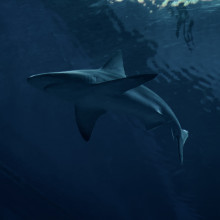
21:45 - Megalodon's teeth reveal extinction cause?
Megalodon's teeth reveal extinction cause?
Jeremy McCormack, Max Planck Institute
Now, scientists believe that they can ascertain prehistoric food chains by looking more closely at the chemical composition of their teeth. Jeremy McCormack from the Max Planck Institute for Evolutionary Anthropology, believes his recent study of the giant Megalodon’s giant gnashers could lead us to the cause of its demise. Harry Lewis reports...
Jeremy - They went extinct around 3.6 million years ago, and they had a worldwide distribution. It is the last member of the so-called mega tooth lineage. And the megalodon itself could have potentially reached sizes of up to 20 meters in total length.
Harry - You were able to compare the diets of different shark species, including that of the great white shark and the megalodon, because they were at one point in time, both swimming around together, and you've used zinc isotopes to do that. How can those isotopes help?
Jeremy - An isotope of course the same element, but with a different mass. So we look at the ratio of the heavier zinc to the lighter zinc in the mineral of these teeth, and this ratio tells us how far up a food chain an animal was feeding. The way this works is that the zinc isotope ratio changes as we move along the food chain within the vertebrae remains of different animals.
Harry - Right. And why is it that teeth make for such good samples?
Jeremy - So we look at teeth because teeth are very well preserved as fossils over millions of years. And because zinc is incorporated into this mineral phase of teeth, we basically can look back millions of years, study the diet along extinct animals.
Harry - Were there any similarities then between the diets of great whites and Megalodons?
Jeremy - There is this hypothesis that the emergence of the great white shark during the early Pliocene led to competition for dietary resources between megalodons and great white sharks and our zinc isotope results show that both species fed on a similar trophic level. And now this does not necessarily imply competition, but it really doesn't reject the hypothesis of competition between both species.
Harry - I've got you. So they could have been eating pretty similar prey. Can we guess at where the diets of these two sharks may have crossed over?
Jeremy - So from fossil evidence, we know that both species, at least occasionally fed on marine mammals. So these included both toothed and baleen whales, although the baleen whales back then were much smaller than they are today. Um, but such kind of fossil evidence is rare, and it only gives us a snapshot of predator-pray interaction and does not give us the information about the regular diet of these species.
Harry - And of course, what makes it so fascinating is it's the first time that this method using zinc isotopes to infer one's position in the food chain has been used on such old samples. So there must be quite a lot more to come. This is an exciting time?
Jeremy - Yeah, that is ultimately the goal to use this new method, to investigate the diet ecology of longing animals, which obviously has important implications for their evolution. But in some cases also their extinction.

25:15 - The World Wide Web: Jubilee Science
The World Wide Web: Jubilee Science
Over the course of Queen Elizabeth II’s reign, undoubtedly one of the biggest ways in which our day to day lives have changed has been the way we interact with each other.
Calls, messaging, the sharing of information, graphics, videos, all things we do on a daily basis over the World Wide Web.
Even her majesty herself has been utilising modern conveniences in the carrying out of her duties over Zoom recently.
In 1989, British computer scientist Tim Berners-Lee built on work computer scientists in the United States had been doing on the internet to turn it from a method for sharing information between scientists in private institutions, to the public open standard that it is today.
To clarify, his innovation was to create the world wide web, which is not the same thing as the internet.
The internet is the way computers connect to each other to share information, using a global system of networks that use the Internet protocol suite, a kind of network of networks. Back when the internet was first being used, computers were directly linked to each other, whereas nowadays computers most commonly connect to a network to be redirected where the user wants to go.
Tim Berners-Lee saw the opportunity to combine this incredible innovation of sharing information between computers with another nifty technique of his era: hypertext.
Hypertext is a piece of text which contains a link to another piece of text, or code, which a web browser can then translate into the graphics and words for the user to view the new page or site on their interface.
Berners-Lee’s intuition was that it would be better if we could browse the web in a similar fashion to the way our brains actually work in real life: not always in linear thought progression, but with links between ideas in multiple directions, that then link to other things, perhaps far from the original thought, like a web. By linking pages within a website, or by taking you to other websites as you encounter new ideas brought on by your experience on the original site, hyperlinks allow the web to imitate the way the brain works and build connections.
He new the power of his invention, for the incredible opportunity it provides to people across the world to share ideas, to the danger it might pose to the way our democracies function, and has been campaigning to see his creation used for good to this day.
As we progress further into an era where many people are experiencing a significant portion of their lives through the internet, his warnings to remain vigilant in the use of this incredible tool is as relevant as it ever was.
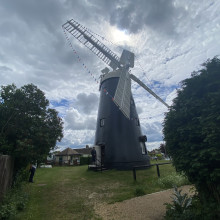
29:18 - How humans historically harnessed wind
How humans historically harnessed wind
Andrew White, Burwell Museum
We've been using wind to generate electricity for over a century, but for thousands of years, and of course long before electricity became our energy currency, wind power was still a staple. Back then, our forebears used it to move water and to grind grain. Julia took a trip to Burwell museum and windmill in Cambridgeshire to hear how...
Andrew - Welcome. My name is Andrew. I am the head of the mill team at Burwell Museum, and we are in charge of maintaining, preserving and operating Steven's Windmill Burwell, which is the last working corn mill in the village. She's 200 years old and I have been working with her for the last eight years.
Julia - Wow. Well, she looks good for 200 years old. How high is the windmill?
Andrew - The main tower is approximately 50 feet and each sail is about 35 feet long. We get nearly a hundred feet by the time you get to the tip of the topmost sail.
Julia - Wow. It's big.
Andrew - Yes. This land has been called Millfield since the 1200s. We have found evidence of windmills dating back to the 1300s.
Julia - So, we've been using wind power all that time.
Andrew - Yes. There has been wind power used in this village for at least 700 years.
Julia - Let's go inside. I'd love to see how that mechanism works.
Andrew - We call this the great spur wheel. It's the largest diameter wheel in the whole building. It is the penultimate gear before the stones. It turns free stone nuts, which then turn the free pairs of stones above. This mill, when it was built, was capable of grinding three different meal; flour, rye, barley, and also had a grain cleaner and a sieving machine to produce white flour.
Julia - All of those different contraptions, are they powered by the wind?
Andrew - All can be powered by the wind, yes. All powered by gears coming down from different gearing and different take-off drives.
Julia - Am I allowed up here? Oh my goodness. This is a steep staircase.
Andrew - This is the most important floor in the mill. This is what we call the stone floor. It is also here that you can see our principle secondary drive, what we call the crown wheel, which was the wind powered drive that drives the auxiliary machinery, including the grain cleaners and the white flower machine, which we call the dresser.
Andrew - (Tapping noise) So, you can hear that noise. That's the shoe, which is rattled by a large lump of metal projecting out of the stone called a mace. That rattling gently feeds grain into the eye of the stone and is then drawn through by the motion of the stones which, in a scissoring action, cuts the grain open and releases the flour. Then it comes through to the shoot which takes it down to the ground floor. In the Victorian period, we had four corn mills in the village alongside countless small drainage mills which assisted in draining the fens. There were many examples of wind power being used for different purposes. We were a corn grinding mill. They also had pumping mills and they also had mills that ground fertiliser for the local farms.
Julia - We're really making the use of the windy area that we live in.
Andrew - Almost certainly. We still use wind power to operate and we are very pleased that we can do that.
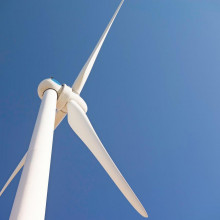
32:52 - Modern day turbine technology
Modern day turbine technology
Karl Whittle, University of Liverpool
Julia - You can feel the wind absolutely whipping on the Northwest coast of England today. I'm currently hiking up a sand dune because when I get to the top of this, I should be able to see some turbines. Let's have a look. Oh my goodness, this is really steep. There they are. And it is really windy. It's pretty misty, but what I can see off in the distance is the Burbo Banks wind turbine offshore farm. From here, I can count 1, 2, 3, 4, 5. They just keep going. Let's get down off this windy hill, shall we? A little bit less windy down here maybe...
Julia - We've moved on from wind being used to produce food produce, like flour, and also draining water systems, to now powering our country. Big offshore wind farms like this one here in Crosby are doing just that. But just how much energy does a farm like this produce? Well, I think I should get off this windy beach and go into town to find out. I've come to the University of Liverpool to meet with Karl Whittle who is an engineer. He's going to tell me how they work.
Karl - They can be up to 150 in radius and they can now get up to 250 in diameter.
Julia - Is that in feet?
Karl - Metres.
Julia - 150 metres? Wow.
Karl - And it's because the larger the area, the more energy you can extract from the wind. You want to go bigger to extract more energy and more energy means you generate more electricity.
Julia - So, as these huge structures are turning round, how is that spinning being converted into energy?
Karl - The easiest way to think of it is like a dynamo on a bike. As you turn the wheel, it turns a generator. The way the generator works is exactly the same as a steam turbine. You have a magnetic coil and you have a magnet rotating around. Then, as it rotates around, it will generate AC current. A wind turbine then converts that to the usable energy that you want, whether it's AC or DC. Then, that gets transmitted to the grid or to wherever it is being used because some wind turbines can be on top of a roof that can then go straight to charging a battery, others can then go to the grid. The ones that you saw Crosby would go to the national grid.
Julia - You've got a diagram up here of the evolution of the wind turbine? It's like a Mercedes sign, a small one all the way up to a big, massive one.
Karl - Yeah, pretty much. That's what it is. They're just getting bigger. They're generating now, I think, the ones we can see at the moment, in the megawatt range of energy. If you have a wind farm of a couple of hundred or a couple of thousand of them, some of the big super ones, you're generating hundreds of megawatts, up to gigawatts, of electricity, which is equivalent to a nuclear reactor.
Julia - How many homes would that power?
Karl - It really does depend on the usage of the home, but one gigawatt would definitely cover Liverpool. And the newer ones will go even further, coming in land, in terms of how much electricity they can provide.
Julia
And what are these turbines currently made out of?
Karl - A range of materials aluminium steels for the stand and for the blades - that'll be made from composites now because we need to get the weight down because the heavier the turbine blades, the more energy it takes to turn them, it's an efficiency gain. We're just trying to get every little bit of efficiency; 10% here, 2% there begins to mount up over time. In some of the early designs, we couldn't really recycle everything. Now, we can recycle most things that come off. We are able to reuse the metals, we are able to reuse the composites if we wanted to. The carbon usage for wind is now to the point, after a number of years, maybe five to ten depending on the wind turbine design where you are now what would be defined as net negative carbon, in that you are generating electricity, compared to gas, that is no longer generating carbon.
Julia - Is there ever going to come a point where nearly all our energy in the UK can come from these structures?
Karl - It is conceivable, based on current usage of electricity, to have days whereby we've got more wind and solar than we have gas. The problem we have with wind is its intermittency. We're lucky where we are, geographically, and there's always wind. There's always wind somewhere. The problem is, some days the wind doesn't blow. So, if you were to look on bright sunny days a couple of weeks ago around here, we did have a bright sunny day with blue skies, but the wind was not strong that day. We relied more on solar than we relied on wind. We either need to increase our wind capacity, or the other way is to have increased energy storage, such as batteries or the use of hydrogen. Because one of the things that you sometimes find is that the wind is turning, but the wind turbines are not turning, because they're not needed for electricity provision on the grid scale. Or, the wind is really blowing and we have to turn the turbines off because we don't want to damage the wind turbines. We need to have other supporting things in place but it is conceivable, based on our current electrical needs, that we could have days in the next 10 years where we don't need gas, we can run on wind and solar together. Nuclear would always be there as a baseline, say, to provide a safe supply for electricity, but there will come a point when we will not need any gas at all in the day. As we move to net zero by 2050, and there are a lot more electric vehicles on the road, we then need to increase capacity even more to cover everybody wanting to charge their cars when they go home. That is a demand management issue.
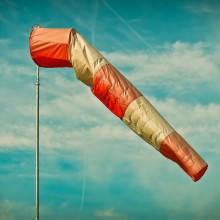
38:20 - More reliable windy weather reports
More reliable windy weather reports
Martin Shields, Colorado State University
Julia - Not knowing when the wind will blow and how hard is one of the main drawbacks confronting energy companies that rely on wind power to supply their customers. If they bank on seeing a certain level of supply, but a law means they're short of power, they have to make up for the shortfall by buying supplies off their competitors, often at shockingly high prices, undermining the viability of their business. But if we improve our short term weather forecasting for turbines so predictions about wind speeds and therefore outputs can be improved, the situation is much less risky for the operators who are more likely to invest. That is what Martin Shields from Colorado State University is trying to do as he explained to Chris.
Martin - Our problem is, how do we provide a better wind forecast to utilities so they can better plan for producing tomorrow's electricity demand.
Chris - That sounds like a bit of a trivial problem, though - it might not be windy tomorrow, we'll just get the electricity from somewhere else? Is that not how it works?
Martin - Well, sure, you can go out on the market and buy it from someone else, but it's a lot more expensive when you expected the wind to blow and it didn't. You have to go out and pay a lot of money for electricity on what's called the spot market.
Chris - Are our forecasting methods good enough to give that kind of fine grain detail, though? What sort of resolution of energy generation, and also wind speeds, are we talking about?
Martin - Well, we are looking at winds that are very localised. We need to know how the wind is going to blow near the wind turbines where the electricity is produced. That's a tough act for forecasters to do. It's really difficult to know how fast the wind is going to blow at any particular time in a very small locale.
Chris - So how are you going to solve that for them?
Martin - We work with scientists at the National Oceanic and Atmospheric Administration, part of the US government, and every day they're hard at work, fine tuning their models. What we do, in our project, is look at how the old model that's currently running does in predicting wind 12 hours ahead versus the developmental model, which is behind the curtains. 12 hours later, we see how good those predictions are. We look at what the cost of a mistake is under each of those regimes. What we found is that, as the model is improved by the scientists, there are substantial savings and that can subsequently be passed on to consumers through lower electricity rates.
Chris - Does this give generators more confidence, essentially, to invest in this and go down this path because rather than take the sure fire way of generating electricity, you burn some coal, or some gas, or some oil, you know how much that's going to cost you, you know that you're going to get electricity at the end of it, and therefore very low risk. Versus, if you've got to take a gamble on the weather, high risk. Whereas if what you are doing can be brought to bear and prove that actually they can save a few bob, it does mean they're more likely to invest in this sort of market.
Martin - Exactly. The uncertainty of wind is an impediment to its adoption. Sometimes it blows and sometimes it doesn't. But, also, the uncertainty about the uncertainty is an impediment. What we're trying to do is remove the uncertainty about the uncertainty, and that provides value to the utility and helps increase the likelihood that they'll use more of it.
Chris - Where are you basing the analysis because is this going to be applicable everywhere? And what about with an eye on the future? People are very worried about climate change and some of the predictions about the rate at which that is going to happen are quite scary because they suggest quite near term changes and they're very variable. There's a lot of those uncertainties that you're referring to geographically as well. Are we looking at an even more uncertain future and therefore how much certainty can you bring to the uncertainty at the moment?
Martin - That's a tough question, Chris. We're doing this for the continental United States and, even within the US, our wind forecasters do better jobs in some places than others. As we introduce climate change - we know it's happening, what we're trying to do is make this transition to whatever the future holds as costless as possible, or as least costly as possible.
Chris - Are utility companies receptive to this kind of thing? Can you see them actually having trust and confidence in the sorts of numbers that you are beginning to generate?
Martin - Yeah. We've talked to a few utilities who are clamouring for this information. It really is an expensive problem when there's a mistake made and anything they can do to keep rates down to consumers, they're excited about. We're just hoping that we can help in that effort. It might be a few dollars per year or a few pounds per year for the average customer but, when you add that up across the economy, it can run into the hundreds of millions of dollars in annual savings and that's money that can be spent on other things. People can have something a little bit more exciting in their lives than electricity.
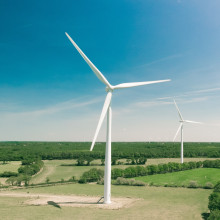
41:59 - Crowd-funded wind turbines now powering homes
Crowd-funded wind turbines now powering homes
Sarah Merrick, Ripple Energy
As the old saying goes, an Englishman's home is his castle. But what about if you wanted to own a wind turbine and use that to power your metaphorical castle? Well, prompted by the idea that a whole turbine might be a bit big for the average home, a few years ago a first of a kind initiative was born that meant you could own part of a wind turbine and use the proportion of it that you do own to cut the cost of your electricity bill by consuming your own green electricity. The idea was quite daring, not least because the company had to persuade people to invest in a turbine that hadn't even been bought or built yet so they could raise the funds to construct it. The CEO of Ripple Energy, the organisation behind the idea, is Sarah Merrick, who spoke to Julia Ravey...
Sarah - There are 907 people that have owned part of that project. We also got a grant from the Welsh government. So that project has been built and it's up and running, and people have got their first savings off their electricity bill as well. It's just a monthly saving that gets applied depending on how windy is. So we had a fantastic April and people saved on average about £24 off their electricity bill. We've had a full cycle of launch project, fund it, build it, and then get savings. We've also launched and funded a second, much bigger project. The first project was one turbine, the next project is Kirk Hill, that's in Scotland. That's eight turbines and that's funded. There's 5,600 people that own part of that project, and it's now going to start construction and it will be generating late next year.
Julia - Can you just give us a reminder of how these schemes work? So if I wanted to get involved and get some of my energy from these wind turbines, how would I go about doing that?
Sarah - Go onto our website, put in how much electricity you use. You then say, "do you want all of that covered by your wind farm or half of it Or 10%?" Once you've decided you then buy the shares in the wind farm, and then we take care of everything else; we manage the operations, we manage the build. And then when the wind farm's operating, your electricity supplier then buys your bit of the wind farm's electricity and supplies it to your home via the grid, and then you get savings off your bill automatically. So it's really, really easy - you can sign up in a few minutes - really flexible, so it doesn't matter if you move home or if you live in a flat or if you rent, anyone can now buy a bit of a wind farm.
Julia - And is that an upfront cost you pay to invest in the wind farm?
Sarah - You pay upfront and it's literally that money is what the wind farm gets built with.
Julia - One of your projects is up in Scotland, one is down in Wales. So do you have to live in the local area to get involved? Does the wind turbine have to be within a certain radius of your home?
Sarah - Because we use the national grid to get the electricity around the country, it doesn't matter where you live. You can't live in Northern Ireland because there's a different grid in Northern Ireland, but yes, you can live anywhere. The whole point of Ripple is to enable everyone, no matter whether you live in the middle of the countryside or in the city centre, everyone can own their own source of clean power now.
Julia - Have you got any projects coming up?
Sarah - We're looking at our third project at the moment. So there's a couple of different options that we're looking at. It might be a solar park, it might be another wind farm, but we want to launch another one hopefully before the end of the year.
Julia - From my perspective, I live in a flat and it sounds like a really great way for people who don't necessarily live, you know, out in the countryside where you could put your own turbine up or have your own solar panels to get that green energy, whilst also making a saving. Do you think this is the future of getting green energy to more people?
Sarah - Absolutely. Part of the beauty of renewable energy is that it can be owned by thousands of people and you can't own a bit of a coal station or a gas station or a nuclear station, but you absolutely can own a little bit of a wind farm or a little bit of a solar park. The benefit as well, like we've seen at the moment electricity prices have gone through the roof, but actually the cost of operating the wind farm has stayed really stable. So it means the savings that you get on your bill are a lot higher when the electricity price is high. So it's a way of enabling millions of people across the country to be able to own their own source of clean power, but get the low cost and stable priced green electricity that that wind farm or solar park generates, and that can help protect them from the price spikes that we've seen at the moment.
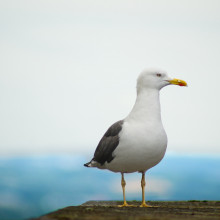
46:11 - Do wind turbines impact wildlife?
Do wind turbines impact wildlife?
Aedán Smith, RSPB Scotland & Alastair Lyndon, Heriot-Watt University
Although wind turbines are providing huge benefits in terms of us getting more clean energy into the UK and around the world, on windy days at least, it's important to recognise that these are really huge, potentially intrusive structures. These turbines jut up hundreds of feet into the air. So what impact is that having on birds which normally fly through these paths? And for offshore wind farms, are they impacting life below the sea? Over to Chris Smith...
Chris - There are thought to be over 8,000 onshore and 2000 offshore turbines in the UK alone now, with numbers still rising. While the energy they generate will over time, of course, form part of our solution to the climate change problem, their immediate impacts on proposed construction sites do of course have to be taken into account...
Aedán - So we're not only in a climate emergency, we're in a nature emergency as well and wind turbines, wind farms -really good at generating low carbon energy, so that's really positive, but they do present some risks to birds and their habitats
Chris - That's Aedán Smith, he's head of policy and advocacy at RSPB Scotland. This danger was highlighted in one of the first wind farms in the United States in Altamont Pass, California...
Aedán - It's really important migratory route for lots of bird species, and lots and lots of birds were tragically killed by colliding with the turbines there as we were passing through
Chris - From this tragic incident, bird behaviours and habitats are now taken into account before a turbine is erected...
Aedán - Working with conservationists and with government agencies to avoid the most sensitive places for the most part. So that fortunately has meant we've not had too many of those really terrible situations like at Altamont pass.
Chris - Even though some may argue that more birds are killed by cars and cats in a year than turbines, particular species might be more vulnerable...
Aedán - There are not all that many Eagles for instance killed by domestic cats, but actually that is a sort of species that is potentially at risk from colliding with wind turbines
Chris - Wind turbines can disrupt bird populations in three ways with the first being...
Aedán - Collision. So collision with a moving turbine blades. The other thing is though that these structures are novel if you like, it's not something which wildlife has evolved to coexist with. So sometimes birds see a turbine and then go absolutely nowhere near it, which is great for avoiding colliding with this structure. But maybe if they avoid an important feeding area or nesting habitat, then that could have an impact on their ability to survive. And a third type of impact is more of a barrier effect. Birds often will nest or roost in a certain location and then go off to feed somewhere else; they're journeying, they're commuting, if you like. And if a wind turbine suddenly appears on that commuting route, they may need to avoid that. And if the bird is using up every last ounce of energy just to survive, and then suddenly it's got to take a longer route, that could maybe tip the balance and tip it over the edge
Chris - These factors are taken into account when sighting turbines to avoid disruption to populations, and we've now got years of data to help us to ensure that the sites on land are selected successfully. But when we look offshore, we don't have a similar body of data to fall back on yet. So it's much trickier to predict what sort of impacts these turbines are going to have on that wildlife. There's currently also a conflict between generating more green energy by erecting more offshore wind turbines, and trying to better understand - and ultimately protect - seabird populations...
Aedán - Fortunately, technology is helping us quite rapidly here. It's possible to put tags on seabirds and that's quite a recent development because the technology has got such that the tags have got small enough that they can fit on some of the smaller seabirds now. And that is really rapidly increasing our knowledge about where birds are going after they're leaving nest sites on the coast, and they're going out to feed out at sea, and also where they're going in the winter.
Chris - But the effects of these offshore wind turbines are not confined just to the air they spin through because scientists are increasingly documenting impacts in the underwater realm too, particularly for crustaceans like crabs and lobsters. Thanks to advances in tracking technology, we can now much better understand how these animals get about. Alastair Lyndon is a marine biologist at Heriot-Watt University, where he's been following the travails of the edible brown crab...
Alastair - Recent tagging work has suggested that they move over quite large distances, particularly the males. And it seems that they, generally speaking, move up the coast from the southeast to the north, and then from the north round the top of Scotland and down the west coast.
Chris - The female crabs, although not traveling as far, still move away from the coastline in order to brood their eggs and ensuring their numbers is vital...
Alastair - Crabs, in terms of volume and value, are the second most important crustacean catch in the UK, as far as fisheries are concerned. They're extremely important for small rural and isolated communities.
Chris - Increased numbers of offshore wind farms means inevitable changes to the surrounding marine environment, which could influence wildlife behaviour...
Alastair - It means that there'll be a lot more electrical cables around on the seabed compared to what there have been in the past. And the implication of that is that they generate a magnetic field around the cable, which can't be shielded. We know that a lot of marine organisms have - or at least we suspect have - magnetic senses, probably for navigation, using the earth magnetic field, which of course is very, very weak. So if they can detect the earth magnetic field that might interfere with any movements or migrations where they might be using that magnetic field for direction finding
Chris - It is currently pretty hard to test this theory out in the water. So Alastair and his team have set up scenarios that mimic this potential electromagnetic field effect in their lab. They did it using a water filled tank with a large coil of copper, called a Helmholtz coil, placed underneath it. And by putting crustaceans in the tank, Alastair and his team have made some striking observations...
Alastair - With edible crabs, brown crabs, when we have electromagnets under their tank and we switch them on, the crabs tend to triangulate on the magnets and then sit there without moving very much. It tends to reduce their activity levels quite substantially when the magnets are on. So it looks as though the magnetic field might actually reduce their natural movements, which might reduce their interactions with other members of the same species, so potentially mate finding, and it might also reduce their ability to forage, to feed and find food
Chris - In terms of developing offspring, the magnetic field also appears to impact another species too...
Alastair - We found that when female lobsters with eggs were exposed to the magnetic fields throughout the eggs developmental phase, the larvae were almost three times as likely to be disrupted in the development in terms of physical deformation and morphological changes. That had an impact on their ability to swim and swimming for these larval stages once they've hatched is very important because they need to be able to swim up to the surface to obtain food.
Chris - Now it's unclear if the cables currently sitting on the seabed have these impacts on crustaceans in the wild, but burying the cable was under the sand, as most companies do, might...
Alastair - Burying the cables would clearly be beneficial because the magnetic field round the cable drops off relatively rapidly with distance.
Chris - But continuing to study these effects, both in the lab and on the shore is important if we continue to move to more offshore wind energy in the future...
Alastair - It's important to know that we're not having unintended negative consequences in trying to do something good. Are the magnetic fields sufficient to disrupt the migrations of male crabs, which might have implications for the population biology of these species? How small a small effect is actually not significant as far as survival of these organisms is concerned, either as larvae or as adults? We don't really know that and we would need to do further tagging experiments to see what sort of movements might be affected by the cables in practice. We might also need to think about the impact of construction of these facilities, which clearly are on quite a large scale as well. The current practice would appear to be adequate, but we still have to continue research to make sure that there aren't any other unintended consequences.
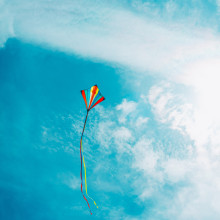
54:27 - Kite turbines that harness wind energy
Kite turbines that harness wind energy
Rod Read, Windswept and Interesting
While turbines present one solution to harness wind energy and transform it into electricity, they are not the only structures to do this. A company in Spain has created the Vortex Bladeless, a six foot tall tower fan-like structure, which wobbles from side to side to produce power. Their lack of huge blades means these can be popped up in more locations and may prove less harmful to birds on land. There is also something else which catches the wind, which could be revolutionary in this technology - kites. Chris Smith spoke to engineer Rod Reed, from Windswept and Interesting, who's designed a kite turbine, which might take wind energy to new heights...
Rod - There's a lifting kite up in the sky that normally would carry a camera. But instead of the camera, this time on the line, we've got this spinning set of kites that are flying around the line and those lines they're turning a generator on the ground. It's like a set of model aeroplane wings tied around in a circle and they're really efficient and fast as they go around. The parachute one, it stays up on the top and adds a little bit of tension into the system so that we can transmit torque down to the ground. Because we hold the tethers apart, and because they're in tension, and the kite blades are out at a distance, we can transmit that torque to ground safely.
Chris - So how much force are they generating then? How much twist is coming down the cables?
Rod - So we get about a kilowatt and a half out of a small model that I'm able to launch myself, but in the next automated one that we're going to work on, there's going to be a robot doing my job in the field. And we'll be taking that one up to 10 kilowatts. But we can stack them in networks, so we're hoping to make really giant ones in the future.
Chris - And how do you avoid having a hideous tangle, which seems to be the outcome whenever I try and fly my kids' kites?
Rod - If you think of putting a single fishing line out, there's a hundred of you trying to fish in the same place, you'll get those tangled very quickly. But instead you could have a few thousand lines in a fishing net, but it doesn't tangle because of the way it's tied together. So we have very stretched out lines.
Chris - And is your view then that you would have, instead of a field full of wind turbines, we could have a field full of kites? And you're basically flying just an array of kites at perhaps a range of heights as well? And in that way, you're just generating all the time.
Rod - We already fly at a range of heights. We stack rotors one on top of the other. So we've got multiple kites on each layer on the turbines that we have.
Chris - What about the environmental impacts of this? Is this noisy?
Rod - Anything moving in wind, anything going fast through wind, is going to make noise. We have a fairly low tip speed ratio as compared to a normal turbine, so it's slightly less noisy. If there was a season that you wanted to be rid of these things, if you had to get them down and you knew there was a flock coming by or something like that, they're very quick. In Norway, there's a kite company that takes their systems down for any given event like coast guard emergencies, and such. We can bring them down within minutes if need to be.
Chris - And what's the ground footprint like?
Rod - Well, I've got systems that at the moment they fit in the back of my car. So I've got an electric car; I can take a turbine with me and recharge. But in the next version, these automated ones, I'm going to be putting on a back line handling system. Having a back line just gives you this safety, this extra line in case anything goes wrong. So that will want to drive at about a radius of 15 metres out from the ground station.
Chris - And the P word always has to come along at some point, what's the price? Is this going to be cheap or is this going to be very expensive?
Rod - You've got about a tenth of the material that standard wind turbine has because the materials are following the forces in this, we're working in tensile systems. So it should be very capital light as we go forward.










Comments
Add a comment